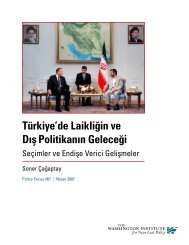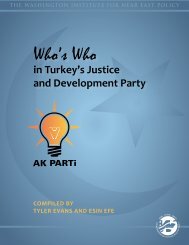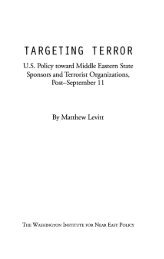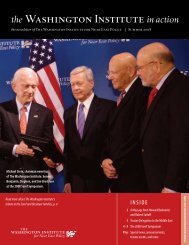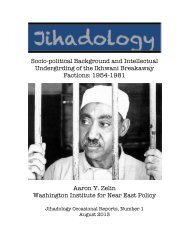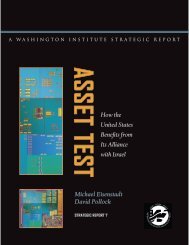alternative foreign policy views among the iranian policy elite
alternative foreign policy views among the iranian policy elite
alternative foreign policy views among the iranian policy elite
Create successful ePaper yourself
Turn your PDF publications into a flip-book with our unique Google optimized e-Paper software.
32 IRAN'S STRATEGIC INTENTIONSIn <strong>the</strong> <strong>foreign</strong> <strong>policy</strong> arena, it believed in full resistance to <strong>the</strong>West and <strong>the</strong> US, support for Islamic and liberationmovements, and close relations with <strong>the</strong> Third World countries.To sum up, this tendency regarded itself as follower of <strong>the</strong>Imam [Khomeini]'s thoughts and was known as <strong>the</strong> "Imam'sline" tendency in <strong>the</strong> society.The o<strong>the</strong>r tendency emphasized giving a free hand to <strong>the</strong>private sector in <strong>the</strong> economic arena... It regarded any effort tosupport <strong>the</strong> deprived and <strong>the</strong> poor as an influence of Marxistand socialist beliefs. In <strong>the</strong> cultural arena, it believed in acertain dogmatism and backwardness which originated from itstraditio~mlist approach to intellectual developments . . . . In <strong>the</strong><strong>foreign</strong> <strong>policy</strong> arena, it had a cautious approach toward <strong>the</strong>West and <strong>the</strong> US, etc . . . .Since <strong>the</strong> emergence of <strong>the</strong> two tendencies, various titleswere used for <strong>the</strong>m: hardline ,and moderate, radical andconservative, left and right, etc. Both <strong>the</strong> domestic and <strong>foreign</strong>media used <strong>the</strong> various terms . . . .It is true that many people, who believe that "<strong>the</strong> one whowins is right," have change color and have co-ordinated<strong>the</strong>mselves with <strong>the</strong> "tide current." The Majlis member for onetown entered <strong>the</strong> Third [1988] Majlis on behalf of one wing(<strong>the</strong> so-called left wing) and entered <strong>the</strong> Fourth [1992] Majlison behalf of <strong>the</strong> o<strong>the</strong>r wing (<strong>the</strong> so-called right wing).The radical and moderate labels each apply to tendencies, not toformal or tightly knit groups. On any issue, lines may blur, withsome radicals taking a more moderate stance on that point andsome moderates taking a more radical stance. To make aWestem analogy, <strong>the</strong> two trends are more like Democrats andRepublican in <strong>the</strong> U.S. Congress than <strong>the</strong>y are like Labor andConservatives in <strong>the</strong> British Parliament: individual egos, not partydiscipline, rule supreme. To continue <strong>the</strong> analogy, much as <strong>the</strong>Democrats have "old Democrats" and "new Democrats," so <strong>the</strong>moderates are split between technocrats (<strong>the</strong> smaller group, withabout 100 of <strong>the</strong> 270 seats in file Majlis but with domination of<strong>the</strong> ministries) and <strong>the</strong> traditionalists (with about 130 Majlisseats). The traditionalists were well described in <strong>the</strong> New York




